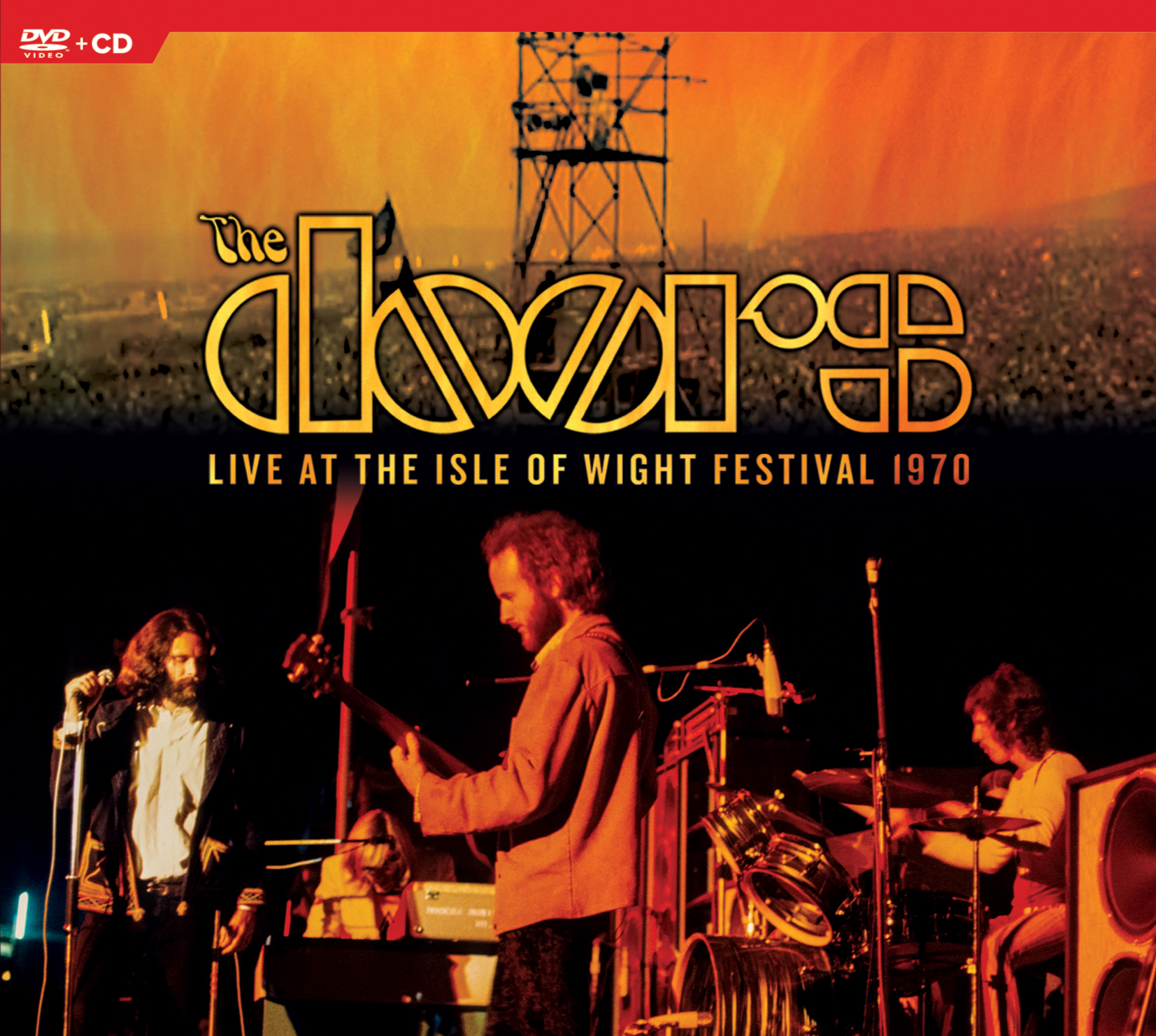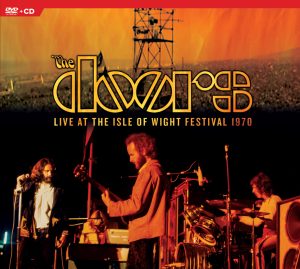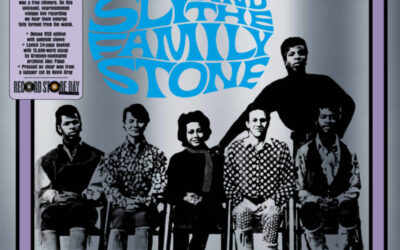on DVD+CD, Blu-ray+CD and Digital Video on February 23, 2018.
C 2018 Harvey Kubernik
The historic last concert ever filmed of the Doors will now be available for the first time in late February 2018  when Eagle Rock Entertainment proudly presents The Doors: Live At The Isle Of Wight 1970 on DVD+CD, Blu-ray+CD and Digital Video.
when Eagle Rock Entertainment proudly presents The Doors: Live At The Isle Of Wight 1970 on DVD+CD, Blu-ray+CD and Digital Video.
The last known unseen performance of the Doors in existence, The Doors: Live At The Isle Of Wight 1970 has been completely recut and remixed, from the original film footage. Fully approved by The Doors, this previously unreleased concert was meticulously restored via the latest 21st century technology, color correcting and visually upgrading the original footage.
The entire concert, which is now presented in 5.1 Dolby Digital sound, was mixed from the original multi-track audio by longtime Doors engineer / mixer / co-producer Bruce Botnick. Fans may have caught a glimpse of this performance in the 1997 Isle of Wight film Message To Love, however this DVD presents The Doors’ set with the full-length songs in maximum visual and sound quality.
The scene is August 1970… Front man Jim Morrison’s ongoing obscenity trial, from an incident a year prior in Miami, weighs heavily on the band. “The Last Great Festival” is taking place in England, which boasted a venerable who’s who of 1970’s top acts: Jimi Hendrix, The Who, Miles Davis, Joni Mitchell, Joan Baez, and more…. The band touches down on the Isle of Wight. The show must go on.
The Doors: Live At The Isle Of Wight 1970 captures and showcases the essence of this poignant performance, as well as offering a snapshot of the era, with footage of fans (over 600,000 in attendance) tearing down barriers and crashing the gates to gain access to the event.
The Doors hit the stage at 2:00a.m. on August 30, 1970, delivering a set that further proved the musical power that marked them as a beacon of the Summer of Love. In this 84-minute DVD, Morrison, organist Ray Manzarek, guitarist Robby Krieger, and drummer John Densmore traverse such staples as “Roadhouse Blues”, “Break On Through (To The Other Side)”, and “Light My Fire”. Illuminated by a mere red spotlight (the band weren’t informed that they needed to bring their own lighting equipment) gave the show an eerie crimson hue, almost echoing the figurative weight of the trial.
“Our set was subdued but very intense,” Manzarek later stated. “We played with a controlled fury and Jim was in fine vocal form. He sang for all he was worth, but moved nary a muscle. Dionysus had been shackled.”
The DVD is completed with bonus featurette “This Is The End” – 17 minutes of interviews conducted by the film’s original director, Academy Award-winning Murray Lerner with Krieger, Densmore, and Doors’ manager at the time, Bill Siddons. Additional archival interview footage with Manzarek from 2002 is also included in the featurette.
I saw the Doors perform in concert at the Forum in Inglewood, California in 1968, and first met and interviewed Ray Manzarek in 1974 at Mercury Records on Hollywood Boulevard.
Ray Manzarek penned the introduction to my 2009 book, Canyon of Dreams: The Magic and the Music of Laurel Canyon. My 2014 book, Turn Up The Radio! Rock, Pop and Roll in Los Angeles 1956-1972, is dedicated to Ray.
In 2010 we discussed the Doors relationship to film and television. Ray revealed the impact a film class had on him while attending the UCLA School of Film with director Josef Von Sternberg (The Blue Angel, Morocco, Shanghai Express). Von Sternberg eventually applauded Manzarek’s student film Evergreen.
The director’s influence informed the way Manzarek and Morrison would eventually wed cinema and music that’s inherent in their audio and celluloid work.
“He’s the guy who really kind of gave a real sense of darkness to the Doors, not that we wouldn’t have been there anyway,” Ray explained. “But having Von Sternberg and seeing the deep psychology of his movies, and the pace at which he paced his films, really influenced Doors’ songs and Doors’ music. The film school is always there.
“Our song structure was based on the cinema. Loud. Soft. Gentle. Violent. A Doors’ song is again, aural, and aural cinema. We always tried to make pictures in your mind. Your mind ear. You hear pictures with the music itself.
“Film school guys founded the Doors. When we made the music, each song had to have a dramatic structure. Each song, whether it was two and a half minutes or an epic like ‘The End’ or ‘When The Music’s Over,’ you had to have dramatic peaks and valleys. And that’s the sense of drama within the Doors’ songs which comes right from the theatre.”
In 1995 at the MET Theatre in Los Angeles I produced, co-curated and read during a month-long Rock ’n’ Roll in Literature Series at the venue.
One night the three surviving members of the Doors reunited for a few songs onstage. During the MET run, John Densmore, along with some musical associates, performed selections from the Bob Dylan and Hawks Basement Tapes.
In 2007 I interviewed John Densmore. I asked him about aspects of theater and film in the Doors’ concert settings and recordings displayed again in this 1970 Isle of Wight DVD.
“I wasn’t thinking cinematic, but certainly Ray and Jim coming out of the UCLA Film School were cinematic dudes. That’s for sure. I mean, I hear the world. Filmmakers see it,” observed John.
“In live performances I had to work harder on the tempo because Ray’s left hand was the bass. And when he took a solo he’d get excited and speed up. ‘Hold it back. Hold it back.’ But, without a separate guy doing bass line runs and grooves there are holes. ‘OK. I’m going in.’ Sometimes I didn’t do anything. That was my territory between the beats.
“Let me tell you, at the Rock and Roll Hall of Fame induction, (Bruce) Springsteen came up to me and said, ‘I like your drumming. It’s so quiet and then you drop a bomb.’ Thank you, Boss.”
In 2013 I interviewed director Murray Lerner about the Doors as well as his unique and influential camera work in this last concert footage captured on the Doors.
Lerner’s The Other Side Of The Mirror-Bob Dylan Live At The Newport Festival 1963-1965, Festival!, re-released in late 2017, and Leonard Cohen Live at the Isle of Wight 1970 are essential DVD documents to view and own.
“I’ve tried to put out the Doors’ [1970 Isle of Wight] full set,” Lerner told me in a 2013 interview. “It was dark but that was the mood. And the darkness is interesting, I think. (Jim) Morrison said to me, ‘you can film but you’re not gonna get an image. But we’re not gonna change our lighting.’ ‘I’ll get an image.’ I did.
“I met and knew (Jim) Morrison earlier at the Atlanta Film Festival. I was showing Festival! It won an award and they had a film they had made played. We talked at the party afterwards, we had both won awards but they were bullshit awards. Mine was for the best music. What does that mean? At the party and I really gave it to the organizer out loud a hard time, told him what I felt about him, and they came up to me and said, ‘We agree with you.’ I got friendly and tried to help them distribute their [Feast of Friends] film.
“The best one of those was at the Santa Fe Film Festival. A documentary panel. Pennebaker was there. (Ricky) Leacock was there. I was there. It was a seminar type thing where people would question us afterwards, you know. It was all about how do you get the money? Not about creative stuff but financial.
“One kid said to Pennebaker, ‘How do you get the money to finance a film?’ And without missing a beat he said, ‘Marry a rich woman.’
“I shot color for the Doors, Leonard Cohen, Miles Davis and the Isle of Wight performers. It was high-speed Ectochrome reversal. And I’m glad I did it because the color lasts a lot better in reversal. The camera people I had were with their own cameras for the most part but they used Arriflexes, and Auricon. The main camera man used was an Aaton, a kind of avant garde camera at the time.
“I always use very very long lenses as an adjunct to my photography. I believe in the long shot because I would like the thing to feel musical and not jumpy. I think film is visual music. And it should be, and I believe in editing that way.”
Lerner further elaborated on techniques employed in his catalog.
“I personally have a technique where I practice the choreography of the camera. Everyday for about an hour before I shot, having an assistant stand by and I would focus, zoom and figure out how big the moves had to be to get the result I wanted so I could do it myself. And I practiced all of that. And I kind of instilled that sense that of the choreography of the camera being part of the concert.
“For the most part, in the planning stages, I picked positions to shoot. And I told people, ‘You concentrate on the close up and you concentrate on something else.’
“I thought the change in Miles Davis was very similar to the change in Bob Dylan and the hostility that he encountered as for them going electric. Because of Dylan, and I read a lot about Miles going electric, it took a lot of courage on his part to go electric.
“That music at the Isle of Wight was cinematic. Like Dylan earlier at Newport. Dylan was at the absolute height of the involvement and the charisma. Absolutely. Of course he has words and Miles doesn’t. It’s a big difference for me. Shooting Miles I knew I had an important moment, especially in a rock music setting. That’s the point.”
For my upcoming book, The Doors: Summer’s Gone, to be published during the first quarter of 2018 by Other World Cottage Industries, I interviewed Tony Funches, my 1969 West Los Angeles College pal, who in 1970 became the Doors’ head of security and Morrison bodyguard. I also connected with former Sounds magazine journalist Sandy Robertson. They both attended the 1970 Isle of Wight festival.
“As I remember it, Isle of Wight gig was difficult,” Tony mentioned in our 2014 conversation.
“Late at night, delays, cold weather, 2:00 a.m. and they were not using their P.A. system. They used the [Grateful] Dead’s P.A. So they had a hard time getting the sound right on the monitors and stuff, and they soldiered on thru. It was pretty miserable in terms of personal comfort. Not that they wanted to be pampered or anything. It was just dreadful conditions.
“I was on the stage. When the Doors are on stage Uncle Tony was there. [Bill] Siddons had one side of the stage and I had the other. They did the gig. Isle of Wight security was really up to the task and there wasn’t really much concern about nitwits come flying out of the audience.
Miles Davis stretched out backstage during the set and we all talked later.
“Jim had the artistic bent that allowed him given his rebelliousness and the idiom he was expressing himself thru to do that improvisation in live performances or on records. He did that in his artistic expressions because that capability was resident within his personality. While at the same time he drew comfort in knowing that others had been doing similar things as with Cab Calloway doing scat singing with the Zoot suit or Bobby Darin when he did ‘Mack the Knife.’
“So he knew of those things but he did not do them as they did but he was aware others had improvised similarly, and since they had, he figured, ‘I’m gonna give it a try. But I can’t do what they do.’ So he did what he did according to what made him tick which made it separate but not equal. But separate.”
“I date my transition to real rock music from my purchase of the sublime Morrison Hotel by the Doors, and my subsequent solo trip all the way from Scotland to the Isle of Wight Festival to see them live, age 17,” Robertson emailed me in August 2017.
“I had a glamorous older cousin named Linda Gamble (later a music and movie publicist) and she seemed the height of sophistication to me because she took a chance on Love and the Doors when no one else I knew had their records.
“None of my buddies cared about Jim Morrison and company, so I fetched up alone amid crowds of 1970 hippies in scorching summer weather with not even a blanket to my name. I saw the Who, John Sebastian, Kris Kristofferson (who was booed for ‘Blame It On The Stones’ by irony-free dolts), and Tiny Tim, who sang ‘There’ll Always Be An England’ to the delight of the mob because he wasn’t being ironic at all.
“Night and cold descended and the Doors didn’t appear until the early hours of the morning – Morrison a distant, gleaming blue-black leather figure, his feral growl on ‘Break On Through’ introduced by Ray Manzarek’s sparkling, icy electric piano. As Kim Fowley rightly has it, in many ways they were like a jazz group, John Densmore’s drum flourishes and Robbie Krieger’s nimble guitar being just as capable of entrancing the ears as kicking ass.
“The critical consensus seems to be that this was not one of their great shows, Jim having his fragile eggshell mind on legal troubles looming, and indeed, looking at footage of ‘Ship Of Fools,’ Morrison seems like he can hardly be bothered to get the lyrics out.
“Nevertheless, at 17 I came to worship, not to deconstruct, and it was only with age I realized how tough it can be for bands to play the same songs every night while trying to deliver an hour for magic.
“Salvation from the cold was at hand in the form of a cute young girl who let me snuggle under her sleeping bag, alas however under the watchful eye of her glowering bro so there was no chance of romance.
“I left pre-Hendrix as a certain thuggishness was in the air. I arrived home with some dreadful flu type virus. Never mind – I had seen the Doors open. To this day, when some kid is playing a Doors album in a record store and I mention I’m so old I actually saw Jim Morrison onstage, it’s great to feel the excitement bridge the generations to that mystical place where people down there like to get it on, get it on.”
(Harvey Kubernik is the author of 12 books. His literary pop culture anthology Inside Cave Hollywood: The Harvey Kubernik Music InnerViews and InterViews Collection, Vol. 1 was published in December 2017, by Cave Hollywood). In the first quarter of 2018 his book The Doors Summer’s Gone will be published by Other World Cottage Industries).







